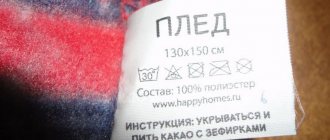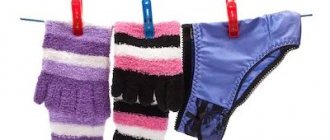What not to do when washing wool products
When starting this difficult task, you should study the most common mistakes, avoiding which it will not be so difficult to care for cashmere or mohair:
- Frequent washing. This is a natural material that is naturally dirt-resistant. It will be enough to wash it twice a year; for freshness, you can simply hang your favorite sweater on the balcony, and dry cleaning is often enough to remove stains.
- You should not soak sweaters and cardigans for a long time - this will lead to severe shrinkage; it is advisable that the whole process takes no more than 45 minutes.
- You cannot change the temperature suddenly. If wool is washed at 30 degrees, then it should be rinsed at approximately the same temperature.
- The material does not tolerate strong friction and squeezing. Therefore, when washing in a washing machine, this mode is turned off or, in extreme cases, set to minimum speed.
- Knitted clothes should not be dried on hangers or on a rope, otherwise they will stretch.
The best option for woolen items
The best way to wash wool is by hand, since not even the most delicate machine mode will give such a result. The item, subjected to minimal mechanical damage, will not lose its appearance, quality and properties.
Hand washing rules:
- use specialized tools;
- the water should be at a temperature no higher than 35-40 degrees;
- the product must be rinsed well;
- When squeezing, such material is not twisted, you can simply squeeze it lightly to remove excess moisture;
- dry by laying it on a flat surface, you can lay a terry towel.
Step by step process:
- Before you start hand washing wool items, they should be cleaned in heavily soiled areas. Place in a container for 5 minutes to wet all the fibers evenly. In a cup, dilute the detergent with water at the same temperature and whip up the foam; when using powder, it is important that it dissolves completely. Having added the soap mixture, start washing, lightly pressing on the product; if there are stains, clean them with a soft brush.
- They also rinse with light pressure in a large volume of water and change it 3-4 times until the foam is completely washed away. They lift the clothes carefully, holding them from below so that they do not stretch; instead of squeezing them, they roll them up with a roller and lightly press them on top. For drying - spread on a horizontal surface in a well-ventilated room.
Important! Before this procedure, you need to check the fabric for color fastness; to do this, carefully pull the fiber out of the fabric and soak it at a temperature above 50 degrees. Then put it on a white napkin and blot it; if it is stained, then add vinegar to the solution at the rate of 5 liters, 2 tablespoons.
Water temperature
Wool, like any other natural material, requires a delicate approach. An important point when cleaning such things is water. It shouldn't be too cold or too hot. It is advisable to add a softening agent to it before starting so that it is not oversaturated with alkali and chlorine. The optimal temperature for wool clothing is 35 degrees.
Washing wool by hand: step-by-step instructions
Washing wool items by hand is the best option. This requires more time and effort, but eliminates the risk of damage to the product. All you need to do is follow simple instructions:
- Fasten the product with all the buttons (lock) and turn it inside out.
- Pour warm water into a large basin and control the temperature (30-35 degrees).
- Add detergent to the water according to the instructions on the package and stir thoroughly until foam appears.
- Lower the woolen item and leave it in the basin for 5-30 minutes.
- Rub the stained areas with stroking movements (you can use a soft brush).
- Rinse the product in plenty of warm water, draining it at least 3 times.
If the label on an item is cut off and you are not sure that it is made of wool, you can check it as follows. From the inside you need to find the free end of the woolen thread that is used to cover the edge of the product (you will need very little, 3-4 mm). Next, you need to carefully cut it off without damaging the integrity of the product itself, and set it on fire with a lighter. The smell of a burnt feather will indicate that the thread is wool. Moreover, if it is 100% natural, it will burn without a residue and turn into black ash, and if it is mixed with synthetics, it will leave a hard, charred head.
How to wash wool items in a washing machine
If you don’t have time to wash by hand, you can do it in an automatic machine. But you need to look at the label to see if this option is allowed for a particular type of clothing. Before you load things into the drum, you need to:
- remove all accessories (clasps, buttons) to prevent damage;
- sew up the loops so that they do not stretch;
- turn a thing inside out;
- separate from other fabrics, divide into dark and light shades;
- When washing multi-colored clothes in one go, be sure to check them for color fastness.
Modern machines have a “wool” program, usually it is already configured in all respects, but if it is not there, you can use the “delicate” mode, but disabling the spin cycle. It is advisable to add a product without synthetic additives in liquid form or a fine-grained, highly soluble powder. After the end of the program, the items are carefully pulled out and excess moisture is removed from them.
Useful tips
There are a number of recommendations obtained as a result of the life experience of housewives on how to properly care for woolen items so that they retain their original appearance for a long time. Here are some of them:
- Do not dry woolen items in or near the kitchen. They absorb odors well.
- Sweat and other unpleasant odors easily disappear from wool, so it is recommended to ventilate it as often as possible in the fresh air in the yard or by hanging it on the balcony.
- Do not use batteries or other heat sources for drying. In this case, the quality of the fabric may deteriorate greatly, and the item will become unpleasant to the touch.
- For long-term storage, it is recommended to use vacuum bags. They will protect the item from insects and help maintain its shape until the next use.
- In the closet where clothes made from natural fabrics are located, you need to put anti-moth products, since they love wool very much and will quickly ruin it.
- If the item is new and has a little dirt, then if possible it is better to have it dry cleaned. This way there is a greater chance that it will retain its shape, size and color.
- It is not recommended to use aggressive bleaches. They can thin the fibers and ruin the fabric.
Comment! Some types of woolen items are not ironed after drying. But there are those whose appearance requires ironing. To do this, turn the product inside out. You can use the steam iron setting or a damp cloth.
Features of washing white woolen items
White clothes become yellowish over time. If ordinary fabrics can be soaked with bleach, then in the case of knitted fabrics this option will not work. You can restore color to white woolen items using several methods.
Soda
Baking soda or soda ash is suitable for severe yellowness. Carefully dilute 2 tablespoons in 10 liters of warm water, adding a couple of drops of ammonia, and pour the solution over pre-washed items. Then rinse well with plenty of water.
We recommend:
How to wash sneakers in the washing machine
Additional Information! Baking soda can be added with each wash to help maintain whiteness.
Chalk
Using chalk you can lightly whiten the product. For 500 grams of wool you will need one kilogram of chalk. It needs to be crushed into powder and diluted in three liters of water, put white things into the mixture and keep them for 10-12 hours. Stir occasionally, as the chalk does not dissolve and will settle to the bottom.
Hydrogen peroxide
A bleach proven over the years. It is diluted in the proportion of one part peroxide to eight parts cool water. Soaking lasts 4-6 hours, then rinse with the addition of conditioner, since the peroxide leaves a medicine smell.
Salt
A medium-strength saline solution will help maintain whiteness. To do this, sodium chlorine is dissolved in hot water and the woolen product is dipped into it several times. Rinse thoroughly to remove any remaining salt crystals. This procedure can be repeated periodically.
Note! You should make sure that dark ones are not lost among the light ones; even if they do not fade, lint may stick to the white, which will irrevocably ruin it.
Laundry powders
The capricious material, made from 100% fur, is capable of deformation from various external factors. For example, high temperature promotes shrinkage, and coarse powders destroy the structure of the thread. Therefore, the choice of product should be approached seriously and with caution. It is better to use special gels for woolen products; their production involves the exclusion or minimization of aggressive substances in the composition.
Modern industry offers mainly gels made from natural and eco-friendly ingredients to care for things made from this material. In addition to liquid ones, you can also find powdered products; unlike conventional powders, they do not contain large crystals.
Recommendations for using detergents:
- Direct contact of cleaning products with the fabric should be avoided; it should be diluted in advance in a small amount of water;
- Gels for wool are well suited, but if the choice is the dry option, let it be a special powder;
- if you urgently need to wash a woolen item, but you don’t have a solution for it on hand, you can use your own shampoo;
- in cases where the situation forces you to resort to regular washing powder, it must be thoroughly dissolved before placing the wool there.
Secrets of experienced housewives
Since ancient times, women have figured out how to wash wool items using folk methods, without using powders and gels. There are three common and time-tested recipes:
- prepare a decoction from 1 kg of white beans in 5 liters of water, cool to 45 degrees and soak clothes - effective for minor stains;
- make a decoction of potatoes - suitable for washing blankets with serious types of stains;
- Grind the mustard powder under running water, strain and soak clothes in one half for 10 minutes, wash with your hands and rinse in the remaining solution.
Important! It is worth excluding the use of laundry soap, as it consists of fatty acids and a large amount of alkalis, which destroy natural fibers.
By adhering to the above rules and recommendations, even the most inexperienced housewife can handle caring for woolen items. If you still have doubts about your abilities, then you shouldn’t take risks, but it’s better to trust the professionals and take your clothes to the dry cleaner.
Rate this post
Drying, ironing and storage
Woolen items should be dried on flat surfaces covered with thick paper or a towel. The process will speed up if the structure is also covered, and a fan helps the process.
With oversized products, proceed as follows: stools are installed at the bottom of the bathtub, blankets, coats, etc. are laid out on them. Water will collect at the edges of things, so in these places it will need to be squeezed out periodically.
Fold dry, clean items and store them in a closet. At the end of the cold season, you will need vacuum bags for clothes. They will protect wool from moths, eliminate accidental snags, and save closet space.
To iron knitted and woven items, you will need gauze or a damp thin cloth. Items made of mohair and angora should not be ironed at all. Cashmere and vigoni can be treated with steam. Keep the iron at a distance. Between the iron and a cashmere sweater, for example, there should be matter.
If the item has shrunk and become deformed, then it should be slightly moistened and, in this form, carefully ironed through the fabric.











